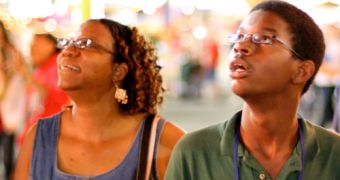Scientists have finally managed to provide us with a potential answer to an ancient mystery, namely why we follow the gaze of others, to see what they're looking at. It could be only curiosity, but, according to a new paper published in a recent issue of the journal Animal Cognition, this behavior is innate in a large part of the animal kingdom, including in humans. It dates back to the times of the first primates, millions of years ago, when this ability is believed to have helped our ancestors and other species better protect themselves from harm, or spot and coordinate attacks on decent preys.
"Because we have found this ability, once thought unique to humans, in lemurs, we can push back the date of its original evolution far beyond the last common ancestor we share with apes, or even with monkeys, back to the time of the first primates," April Ruiz, a psychologist at the University of St Andrews, who has been a part of the current research, along with colleagues Juan Carlos Gomez and Richard Byrne, says.
"Humans find it impossible not to look up when they see someone staring upwards at the sky, even when they know it might be a trick. We are not alone in this habit: it's been known for some years that several species of non-human primates, apes and monkeys, show the same tendency to follow gaze. But when their ability to use this to find useful information has been tested, they generally failed," professor Byrne adds.
"The ability to track gaze makes excellent sense for a social animal like a primate, because it can give clues about foods to eat, predators to avoid, social scenarios to take note of and so on. Up to now, the abilities of non-human primates to interpret gaze have puzzled scientists – the paradox being, what is the point of gaze following if it isn't used for basic functions such as locating resources?" Gomez explains.
Because in lab experiments conducted on lemurs the animals were able to use their collective gaze to find food, the researchers have hypothesized that this behavior might have indeed helped species become better adapted to their environment, and may have also contributed to a stronger "pack" feeling. Even today, there are animals such as the mongoose that scout the horizons together, and turn as one to face one direction or the other.
A further step on the evolutionary scale would be for them to sit in a circle, with each member facing another direction. This would imply a drastically-increased sense of cooperation between the individuals making up the group, and could make the connections between them even tighter.

 14 DAY TRIAL //
14 DAY TRIAL //